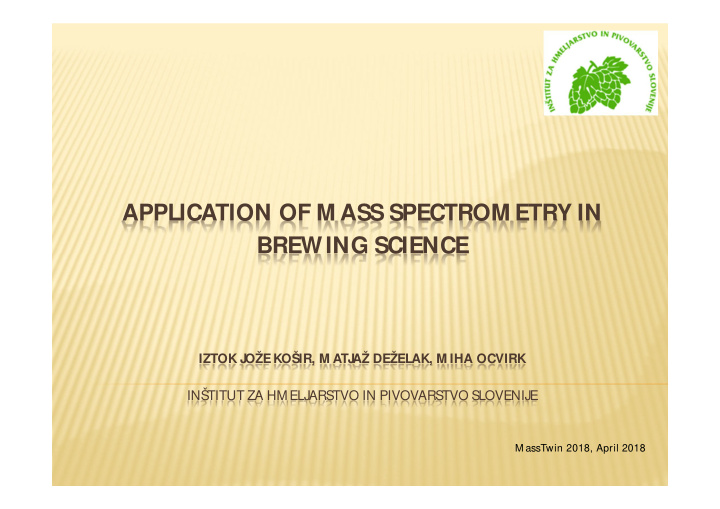



APPLICATION OF M ASS SPECTROM ETRY IN BREWING SCIENCE IZTOK J OŽE KOŠIR, M ATJ AŽ DEŽELAK, M IHA OCVIRK INŠ TITUT ZA HM ELJARS TVO IN PIVOVARS TVO SLOVENIJE M assTwin 2018, April 2018
OUTLINE Introduction • Beer • Beer aroma • Gluten-free beer-like beverages • Raw materials origin (hops) Methodology • Analytical techniques • Chemometrics Results Conclusions
INTRODUCTION - BEER Beer is traditional beverage More than 7000 years old (served as a food and payment method) It‘s a beverage of choice – one of the bestloved foodstufes of a mankind Third most consumed drink overall after water and tea Water, barley and hop (yeast) (1516 Reinheitsgebot)
Introduction – Beer aroma Volatile and non volatile compounds originating from raw materails – hop, barley Also byproducts of fermentation – esters, higher alcohols and phenols - major part of beer aroma Hop – key role for beer aroma • alpha-acids – beer bitternes • composition of essential oils – - beer aroma
Before leaving brewery - sensory evaluation of beer samples with panel consisted of experts Marks for assessed impression from 1 (not acceptable) to 5 (acceptable) Acceptability is in connection with the detection of any off flavors or aroma inbalance. Influence of human factor and subjectivity Solution = objective chemical analysis of beer aroma Data bank for constructing a model able to classify samples according to their characteristic
Introduction - Gluten-free beer-like beverages Celiac disease estimated worldwide prevalence : 1% of the general population treatment : a strict gluten-free diet SOLUTION: Production of beer-like beverages from gluten-free sources like buckwheat, quinoa or millet PROBLEM: Quality of taste and aroma
Introduction - Raw materials origin - hops Hop is a key raw material for beer aroma. Amount of bitter substances, quantity and composition of essential oils depends on pedoclimatic conditions GEOGRAPHICAL ORIGIN
HOW CAN WE ASSESS AROMA QUALITY? WHICH BEER IS MORE APPROPRIATE?
HOW CAN WE ASSESS AROMA QUALITY? SENZORIAL CHEMICAL Star/oksidiran hmelj VISUAL Y GC - FID GC - MS T ASTE Svež hmelj ODOUR ST ATISTICS OVERALL IMPRESSION SUBJECTIVE OBJECTIVE
SENSORIAL ASSESMENT 2 2 different batches of the same beer type Sensorial assesment by the panel of 6 - 7 members Marks from 5 – 1 Cut-off point at average 3 .5
CHEMICAL ASSESMENT Analytical chemical techniques Hop essential oils components in beer (GC-FID) – 15 components. (quantitatively) Higher esters and alcohols (GC-FID) – - 9 components (quantitatively) Analysis of volatile aroma profile (HS-SPME GC/ MS) - 33 volatiles without sample pretreatment analyses were performed under the semiquantitative conditions.
CHEMICAL ASSESMENT - GC/MS chromatograms of samples - Used as fingerprints - Identity of all compounds is not confirmed - Noticable differences between samples - Peak areas used as input parameters in statistics Ocvirk M., Kočar Mlinarič N., Košir I. J. 2018b. Comparison of sensory and chemical evaluation of lager beer aroma by GC and GC/MS. J.Sci.FoodAgric ., DOI: 10.1002/jsfa.8840
WHAT WE GET? A lot of data that seems to be completely confused PROBLEM ? ? ?
Recommend
More recommend